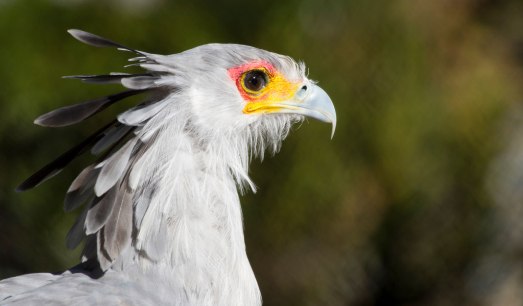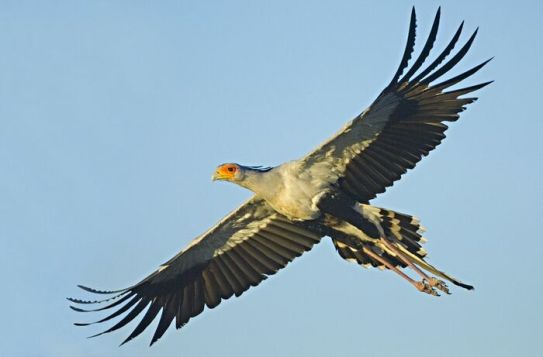Imagine a bird with the head of an eagle, the legs of a crane and the crest of a cockatoo. Imagine that this creature has a bright orange face, stands over a metre tall and stamps its prey to death. It’s probably quite hard to imagine such a beast, luckily there’s an animal that fits this criteria perfectly – the secretary bird (Sagittarius serpentarius). Native to the open grasslands and savannas of sub-Saharan Africa, the secretary bird is a large bird of prey, and one of the few raptors to hunt on the ground.

The secretary bird has an unusual plumage. Its body is mainly grey and white in colour, with black flight feathers. They also have black thighs that make them look like they’re wearing shorts (to me at least). Adults have a featherless, red-orange coloured face that makes them easily identifiable. You may be wondering why they are called secretary birds – it’s due to their black head plumes. This crest of long feathers resembles the quill pens once used by office-workers.

These birds hunt their prey on foot. They have developed highly effective hunting methods to capture a range of prey including snakes, lizards, mongoose, mice, hares, insects, tortoises and other birds (as well as their eggs). They will often stomp around in tall grass to flush out startled prey. Then, they will chase after their victim and either strike them with their bill or stamp on them until rendered unconscious. Cleverly, they have also learnt to wait near fires and quickly gobble up animals trying to escape the heat. The charred taste is an added bonus.

Secretary birds are expert snake hunters. Their legs are adapted to this lifestyle with thick scales, protecting them from snake bites. Once they have found a suitable snake to hunt, they will jump onto their back with great force. If this initial blow doesn’t kill them, the bird will kick the snake repeatedly, aiming to snap their neck or back. It is thought that they may also take flight with their prey and drop them to their doom. Their meal is then usually swallowed whole. Like so many of Africa’s animals, and indeed the world’s wildlife, these fierce yet comical raptors are threatened by habitat loss. However, their varied diet and efficient hunting methods has allowed them to survive some of the changes to our planet for now.
Sources:
http://www.krugerpark.co.za/africa_secretary_bird.html
https://en.wikipedia.org/wiki/Secretarybird
https://www.britannica.com/animal/secretary-bird
Hennessy, K., Wiggins, V. (2014) Animal Encyclopedia: The Definitive Visual Guide. 2nd edn. London. Dorling Kindersley.